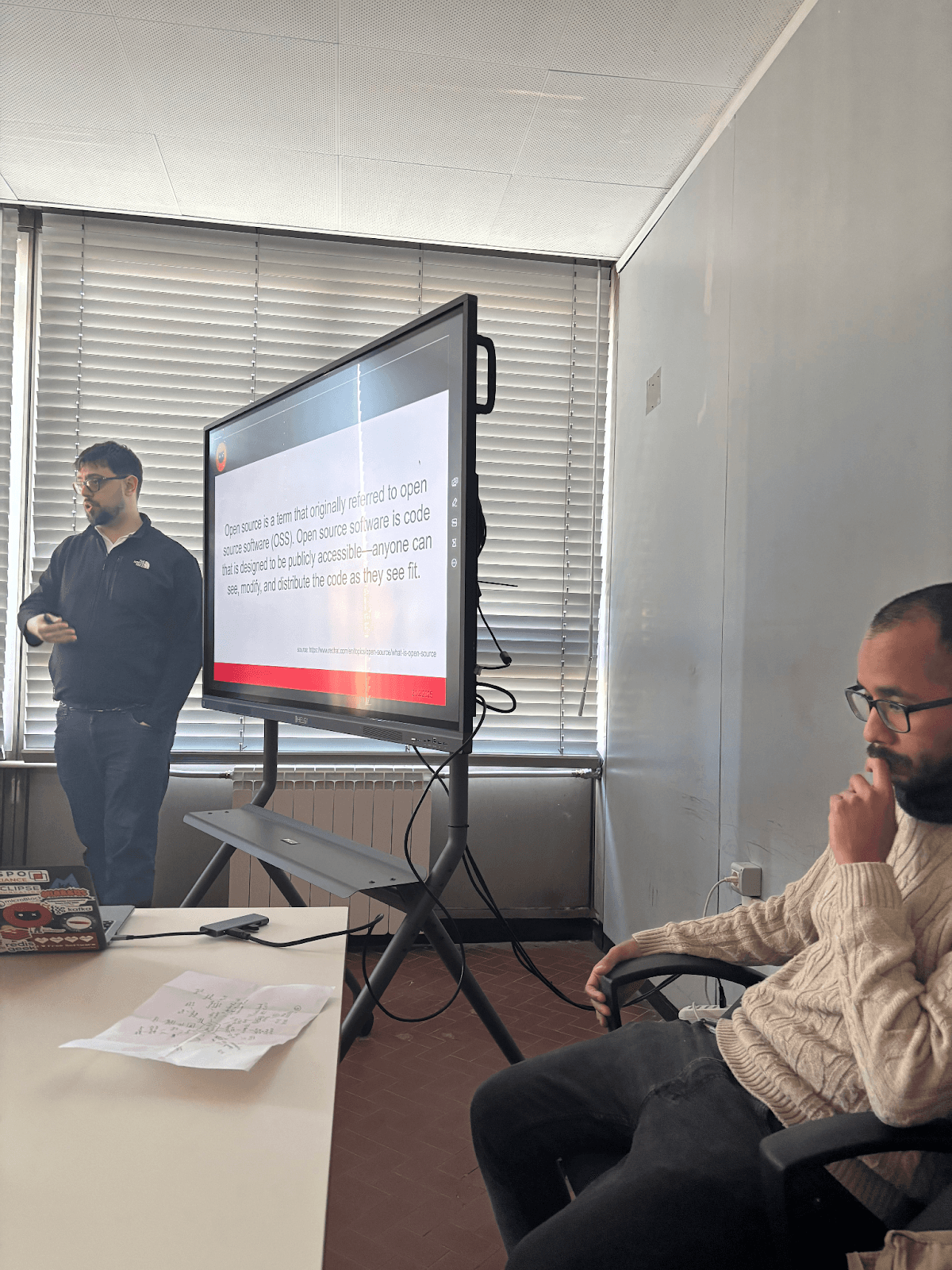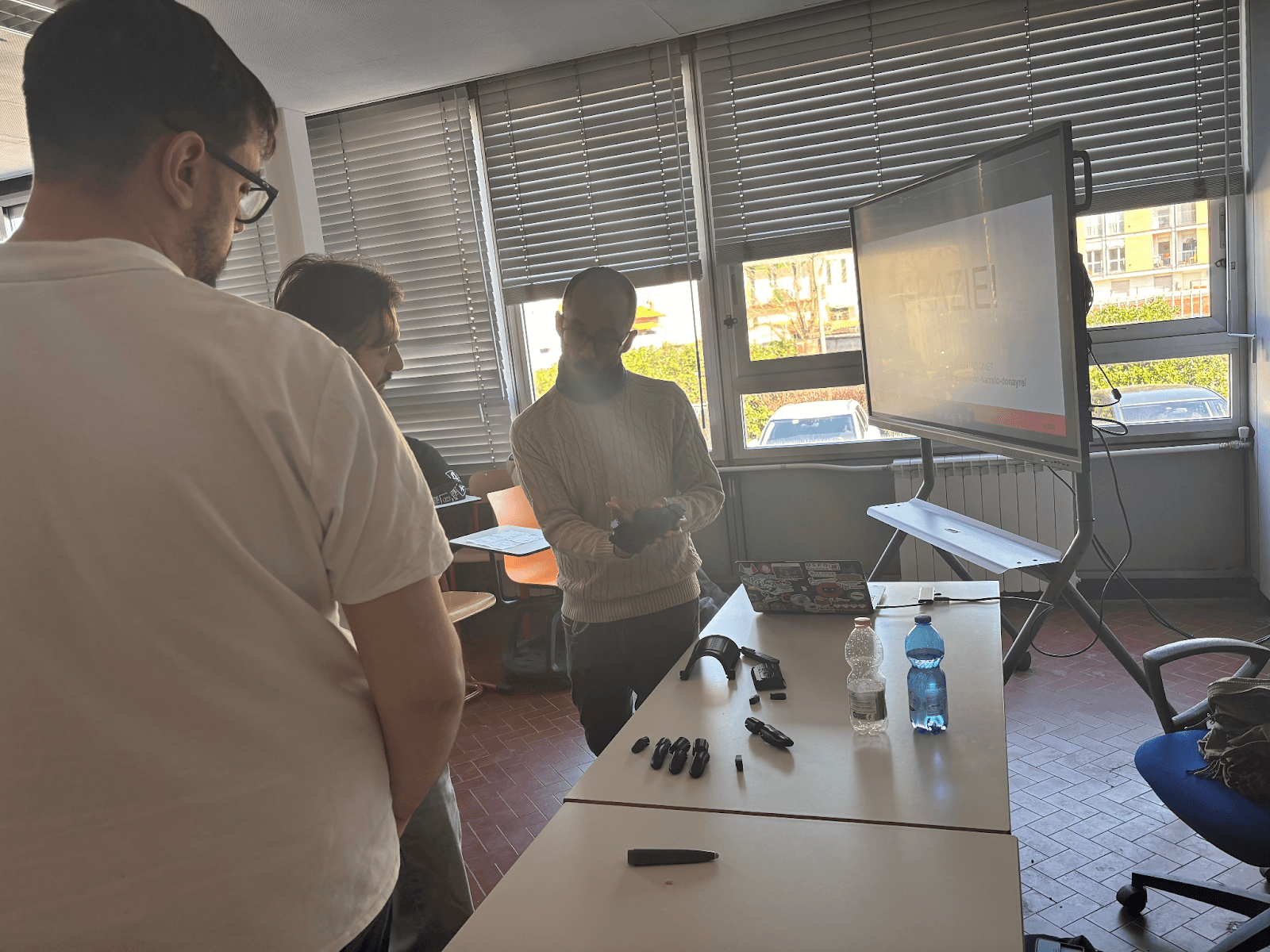
Members of Schrödinger Hat prepare to teach about Open Source to high school students
Bringing Open Source to the Classroom: Our experience at Liceo Meucci
By Andrea Chiara Baldi
28 April, 2025
Some time ago, we were invited to give a lesson about the Open Source world at ITIS Meucci
Why? Our goal was to show to the young students (age between 15 and 19) the principles of open source.We explored the power and potential of Open Source software, not just as a technological concept, but as a philosophy. Making Open Source code means making something for everyone, with no bounds, but only for the community, with the idea that shared knowledge can spark real-world change.
An events made by students for students
Our presentations have been included into two days of self organizing school lessons. The students created their own agenda with preferred topics, made the entire logistics behind and invited guest speakers across different courses.
All those topics, somehow related to their field of study, were something particular and that's where Open Source fits best.
Why is it worth it for your code to be Open Source? What does it accomplish, how to become an Open Source developer, what types of Open Source projects do we use in our daily life?
Starting from here, we decided to divide the lessons into three macro areas: what open source is and what it is for, how we can leverage it for (with a case study) and why communicating its philosophy it is so important.
We organized two sessions, both around 90 minutes long with two different groups of students attending, for a total of around 60 students.
The lesson
We started by presenting Schrödinger Hat, who we are and what we do.
We explained the story of our association, how it began during COVID-19 and how, over time, we grew in a community.
We presented our community, the events we organize, our channels, our social media and our own Open Source projects.
This got the students interested, mostly older students who will be in university in September and have to choose which path to follow.
They were pretty fascinated by the work we do and had lots of questions about the events we organize and how to participate in them, where they can find us and learn more about our reality.
Then, we proceeded to talk about Open Source.
We began by breaking down the fundamentals: what “Open Source” really means and why it matters.
Unlike proprietary software that hides its inner workings, open source projects are built on the idea that source code should be freely available to anyone who wants to learn from it, improve it, or adapt it for their own use.
From here the conversation quickly expanded beyond just code.
Open Source is a model of collaboration, where people from around the globe contribute ideas, tools and improvements, not for financial gain but because they believe in making things better, together.

This naturally led to a discussion about values: transparency, community ownership, accessibility and empowerment. Many students were surprised to learn how much of the digital infrastructure we rely on a daily basis runs on Open Source code (like the Linux operating system, the Firefox browser or the Wikipedia encyclopedia).
These are things we all use yet we rarely stop to think about who builds them and why.
We then proceeded to the most impactful parts of the lesson, a case study where Open Source principles have been applied in one of the most humane and innovative ways imaginable: 3D printing prosthetic limbs for people in need.
Using Open Source hardware and software, it is possible to design and print low-cost, customizable prosthetic arms and legs for people who have lost limbs.
These designs are freely shared online, allowing anyone with access to a 3D printer to manufacture a prosthesis at a fraction of the cost of traditional methods. Not only is this work transformative for individuals but it also highlights the broader potential of Open Source.
This brought up the attention of the students, because something that people never think about Open Source is how much it can improve our everyday life.

Some of them were interested in beginning to write open source code, and so we discussed platforms like GitHub and GitLab (something they already had heard of during classes), and talked more about the Open Source community. We emphasized the fact that this community thrives on the idea that everyone, regardless of skill level, has something valuable to contribute. In fact, unlike more traditional, competitive environments, open source pr ojects actively welcome newcomers and value the process of mentorship. Even if you are completely new to coding or design, you will almost always find someone willing to guide you, answer your questions, and help you take your first steps.
As the lesson wrapped up, we were at the disposal of the students for any questions, and we were very happy to see that not only were the students interested in knowing more about that world, but also the teachers were engaged and curious.
We reflected together about one final, crucial point: the power of communication.
Open Source thrives when people share not just code, but knowledge, experiences and invitations to collaborate. It’s about building a culture where people help each other, build together, and turn shared ideas into tools that make life better for everyone.
Final thoughts

In the end, both sessions were engaging, interesting and interactive.
We were surprised by all the questions and the engagement everyone showed and this made us pretty proud of the projects we are building.
The point beyond coding is that Open Source is a way of living to improve everyone’s lives. We need to collaborate in order to grow together, and bringing this philosophy to the students is an important goal.
That’s why we were inspired and decided to expand this initiative by bringing lessons on Open Source culture to more high schools and universities, in the next months.
We firmly believe that introducing students early to the values of collaboration, transparency, and shared innovation can spark a lifelong passion—not just for technology, but for making a difference.
If you are a student, a teacher, a school administrator, or a university professor who would like to know more about offering your classes a unique opportunity to explore the world of Open Source, we would love to hear from you. Get in touch with us and let's make open knowledge accessible to everyone!
Write us here: hello@schroedinger-hat.org